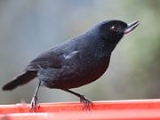
Flowerpiercer
Encyclopedia
The flowerpiercers are the members of two genera
of tanager
s, Diglossa
and Diglossopis
. The latter genus is sometimes subsumed into the former, but at present most authorities maintain them as separate. Based on mtDNA, the Indigo Flowerpiercer, which traditionally has been placed in Diglossopis, actually belongs in Diglossa. The common name
refers to their habit of piercing the base of flowers to access nectar that otherwise would be out of reach. This is done with their highly modified bills, although this is greatly reduced in the Bluish Flowerpiercer, which has an almost "normal" bill. Most flowerpiercers are restricted to highlands, especially the Andes
, in South America
, but two species occur in Central America
.
Genera
Genera is a commercial operating system and development environment for Lisp machines developed by Symbolics. It is essentially a fork of an earlier operating system originating on the MIT AI Lab's Lisp machines which Symbolics had used in common with LMI and Texas Instruments...
of tanager
Tanager
The tanagers comprise the bird family Thraupidae, in the order Passeriformes. The family has an American distribution.There were traditionally about 240 species of tanagers, but the taxonomic treatment of this family's members is currently in a state of flux...
s, Diglossa
Diglossa (bird)
Diglossa is a genus of flowerpiercers in the family Thraupidae. Sometimes classified in the bunting and American sparrow family Emberizidae, more recent studies have shown it to belong in the Thraupidae...
and Diglossopis
Diglossopis
Diglossopis is a genus of blue flowerpiercers in the family Thraupidae. They are closely related to the genus Diglossa, and some retain all flowerpiercers in that genus. They were formerly classified in the bunting and American sparrow family Emberizidae, more recent studies have shown it to belong...
. The latter genus is sometimes subsumed into the former, but at present most authorities maintain them as separate. Based on mtDNA, the Indigo Flowerpiercer, which traditionally has been placed in Diglossopis, actually belongs in Diglossa. The common name
Common name
A common name of a taxon or organism is a name in general use within a community; it is often contrasted with the scientific name for the same organism...
refers to their habit of piercing the base of flowers to access nectar that otherwise would be out of reach. This is done with their highly modified bills, although this is greatly reduced in the Bluish Flowerpiercer, which has an almost "normal" bill. Most flowerpiercers are restricted to highlands, especially the Andes
Andes
The Andes is the world's longest continental mountain range. It is a continual range of highlands along the western coast of South America. This range is about long, about to wide , and of an average height of about .Along its length, the Andes is split into several ranges, which are separated...
, in South America
South America
South America is a continent situated in the Western Hemisphere, mostly in the Southern Hemisphere, with a relatively small portion in the Northern Hemisphere. The continent is also considered a subcontinent of the Americas. It is bordered on the west by the Pacific Ocean and on the north and east...
, but two species occur in Central America
Central America
Central America is the central geographic region of the Americas. It is the southernmost, isthmian portion of the North American continent, which connects with South America on the southeast. When considered part of the unified continental model, it is considered a subcontinent...
.
Species
- Genus DiglossaDiglossa (bird)Diglossa is a genus of flowerpiercers in the family Thraupidae. Sometimes classified in the bunting and American sparrow family Emberizidae, more recent studies have shown it to belong in the Thraupidae...
- Cinnamon-bellied Flowerpiercer (Diglossa baritula).
- Slaty FlowerpiercerSlaty FlowerpiercerThe Slaty Flowerpiercer, Diglossa plumbea, is a passerine bird which is endemic to the highlands of Costa Rica and western Panama.This is a common bird in mountain forest canopy and edges, and especially in sunlit clearings and areas with flowering shrubs, which can include gardens...
(Diglossa plumbea). - Rusty Flowerpiercer (Diglossa sittoides).
- Venezuelan FlowerpiercerVenezuelan FlowerpiercerThe Venezuelan Flowerpiercer is a species of bird in the Thraupidae family. It is endemic to Venezuela.Its natural habitat is subtropical or tropical moist montanes. It is threatened by habitat loss.-References:...
(Diglossa venezuelensis). - Chestnut-bellied Flowerpiercer (Diglossa gloriosissima).
- White-sided Flowerpiercer (Diglossa albilatera).
- Glossy Flowerpiercer (Diglossa lafresnayii).
- Moustached Flowerpiercer (Diglossa mystacalis).
- Merida Flowerpiercer (Diglossa gloriosa).
- Black Flowerpiercer (Diglossa humeralis).
- Black-throated Flowerpiercer (Diglossa brunneiventris).
- Grey-bellied Flowerpiercer (Diglossa carbonaria).
- Scaled Flowerpiercer (Diglossa duidae).
- Greater Flowerpiercer (Diglossa major).
- Genus DiglossopisDiglossopisDiglossopis is a genus of blue flowerpiercers in the family Thraupidae. They are closely related to the genus Diglossa, and some retain all flowerpiercers in that genus. They were formerly classified in the bunting and American sparrow family Emberizidae, more recent studies have shown it to belong...
- Indigo Flowerpiercer (Diglossopis indigotica).
- Deep-blue Flowerpiercer (Diglossopis glauca).
- Bluish Flowerpiercer (Diglossopis caerulescens).
- Masked Flowerpiercer (Diglossopis cyanea).

